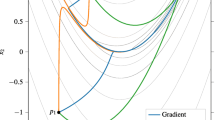Abstract
A class of techniques is investigated for determining at least three components (two translational and one rotational) of the motion of a rigid body from silhouette images, with particular emphasis on motion within a fluid. The investigated techniques all employ edge detection followed by some form of least-squares fitting to the detected points in determining the movement of the body. Four techniques are discussed and, through both an artificial image analysis and calibrated sphere measurements, are shown to be capable of measuring displacements down to a few thousandths of a pixel under low image-noise conditions (\(\lesssim2\%\)). Measurements of two configurations in a high-enthalpy shock tunnel demonstrate the capabilities of the techniques under experimental conditions. In particular, a technique referred to as edge-tracking is introduced, which can be employed in situations where the model profile is unknown and/or only some fraction of it is visible. This latter quality is especially useful for measurements in high-enthalpy facilities, where test-gas luminosity can obscure a significant extent of the model outline. A further advantage of this technique is that, even for complex geometries, the fitting procedure can typically be reduced to solving a sequence of linear least-squares problems, rather than a nonlinear one, with a corresponding benefit in computational efficiency.














Similar content being viewed by others
References
Ballard D (1981) Generalizing the Hough transform to detect arbitrary shapes. Pattern Recogn 12(2):111–122
Bernstein L (1975) Force measurements in short-duration hypersonic facilities. AGARDograph No 214
Canning T, Seiff A, James C (1970) Ballistic-range technology. AGARDograph No 138
Canny J (1986) A computational approach to edge detection. IEEE Trans Pattern Anal Mach Intell 8(6):679–698
de Castro E, Morandi C (1987) Registration of translated and rotated images using finite Fourier transforms. IEEE Trans Pattern Anal Mach Intell PAMI 9(5):700–703
Etoh T, Poggemann D, Kreider G, Mutoh H, Theuwissen A, Ruccckelshausen A, Kondo Y, Maruno H, Tabuko K, Soya H, Tajehara K, Okinaka T, Takano Y (2003) An image sensor which captures 100 consecutive frames at 1,000,000 frames/s. IEEE Trans Electron Dev 50(1):144–151
Gander W, Golub G, Strebel R (1994) Least-squares fitting of circles and ellipses. BIT 34:558–578
Hannemann K (2003) High enthalpy flows in the HEG shock tunnel: Experiment and numerical rebuilding. In: 41st AIAA aerospace sciences meeting and exhibit. Reno, Nevada
Laurence S, Hornung H (2009) Image-based force and moment measurement in hypersonic facilities. Exp Fluids 46:343–353
Laurence S, Karl S (2010) An improved visualization-based force-measurement technique for short-duration hypersonic facilities. Exp Fluids 48:949–965
Marston J, Yong W, Thoroddsen S (2010) Direct verification of the lubrication force on a sphere travelling through a viscous film upon approach to a solid wall. J Fluid Mech 655:515–526
Mettler B (2010) Extracting micro air vehicles aerodynamic forces and coefficients in free flight using visual motion tracking techniques. Exp Fluids 49:557–569
Settles G (2006) Schlieren and shadowgraph techniques. Springer, New York
Spoor C, Veldpaus F (1980) Rigid body motion calculated from spatial co-ordinates of markers. J Biomech 13:391–393
Thoroddsen S, Etoh T, Takehara K (2008) High-speed imaging of drops and bubbles. Ann Rev Fluid Mech 40:257–285
Verbeek P, van Vliet L (1994) On the location error of curved edges in low-pass filtered 2-d and 3-d images. IEEE Trans Pattern Anal Mach Intell 16(7):726–733
Warren W, Kaegi E, Geiger R (1961) Shock tunnel experimental techniques for force and moment and surface flow direction measurements. ARS J 31(1):82–83
Yang FL, Hunt M (2006) Dynamics of particle-particle collisions in a viscous liquid. Phys Fluids 18:121506
Zhang Z (1997) Parameter estimation techniques: a tutorial with application to conic fitting. Image Vis Comput 15(1):59–76
Author information
Authors and Affiliations
Corresponding author
Rights and permissions
About this article
Cite this article
Laurence, S.J. On tracking the motion of rigid bodies through edge detection and least-squares fitting. Exp Fluids 52, 387–401 (2012). https://doi.org/10.1007/s00348-011-1228-6
Received:
Revised:
Accepted:
Published:
Issue Date:
DOI: https://doi.org/10.1007/s00348-011-1228-6




